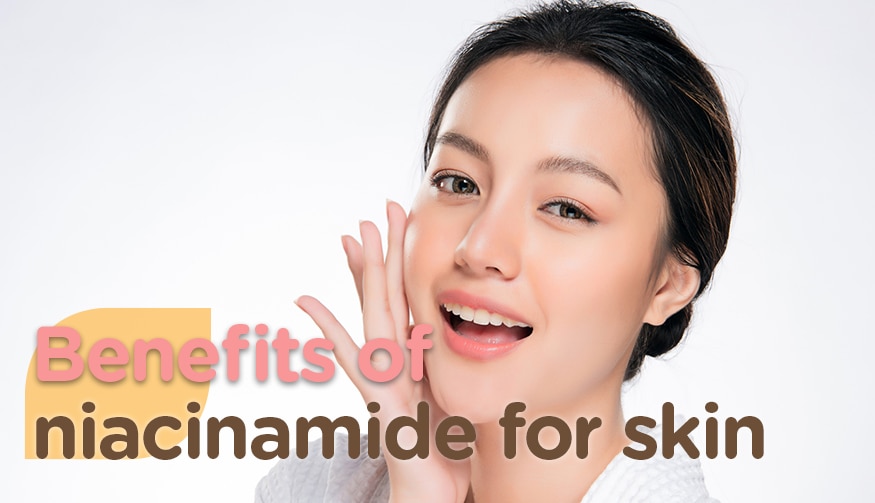Welcome to our skincare corner! If you’re on a quest for healthier, glowing skin, you’ve come to the right place. Let’s talk about niacinamide, also known as vitamin B3. This gem of an ingredient is getting a lot of love in the skincare world, and for good reason. Curious to know more? Let’s dive in!
An Introduction to Niacinamide
Niacinamide is a special form of vitamin B3 that works wonders for your skin. Unlike niacin, it doesn’t cause flushing, so it’s perfect for all skin types. Niacinamide has a unique chemical structure that allows it to work wonders on your skin. It’s water-soluble, meaning it’s easily absorbed and super effective.

Reaping the Benefits of Niacinamide
Niacinamide, or vitamin B3, is a skincare powerhouse with lots of benefits. Let’s delve into why you should consider incorporating niacinamide into your skincare routine:
1. Refines Skin Texture and Tone: Niacinamide can polish your complexion by smoothing rough skin texture and balancing skin tone.
2. Diminishes Fine Lines and Wrinkles: It stimulates collagen production, reducing the appearance of fine lines and wrinkles for a youthful-looking glow.
3. Regulates Sebum Production: For those battling oily skin, niacinamide can regulate sebum production to keep your skin balanced and less prone to breakouts.
4. Soothes Inflammatory Skin Conditions: Its anti-inflammatory properties can calm skin irritation, making it beneficial for acne, rosacea, and eczema.
5. Fortifies Skin Barrier: Niacinamide can strengthen the skin barrier, preventing moisture loss and shielding the skin from environmental stressors.
6. Antioxidant Qualities: It acts as an antioxidant, neutralizing free radicals and defending the skin from oxidative stress, which can reduce signs of ageing.
7. Suitable for All Skin Types: Whether you have dry, oily, sensitive, or combination skin, niacinamide is a versatile ingredient that is generally well-tolerated.

How to Use Niacinamide in Skincare Products
Niacinamide’s compatibility with other ingredients makes it a versatile addition to any skincare routine. You can find it in serums, moisturizers, and even some cleansers.
Niacinamide toners help balance the skin’s pH and add a boost of hydration right after cleansing. They can also help refine pores and smooth the skin’s texture. After cleansing, apply niacinamide toner using a cotton pad or by patting it directly onto the skin with your hands. Follow up with serum and moisturizer.
- COSMODERM Niacinamide Niacinamide Calming Toning Water
- SKINTIFIC Niacinamide Brightening Essence Toner
- BEAUTY FORMULAS Niacinamide Exfoliating Toner Pads

Niacinamide serums, with their high concentration, can penetrate deep into the skin, addressing specific skincare concerns like hyperpigmentation and wrinkles. Serums are also generally lightweight and absorb quickly, making them ideal for layering under other skincare products without feeling heavy or greasy. Apply serum after cleansing and toning but before moisturizing. Use a few drops and gently pat it into your skin, allowing it to fully absorb.
- OLAY Luminous Niacinamide Rose Face Serum
- SKINTIFIC 10% Niacinamide Serum
- BEAUTY OF JOSEON Glow Serum Propolis + Niacinamide
In moisturizers, niacinamide enhances the skin’s barrier function, locking in moisture and reducing redness. This makes it suitable for those with sensitive or acne-prone skin. After you have applied serum, follow up with a niacinamide-infused moisturizer. This can be used both morning and night to ensure continuous hydration and protection.
- SKINTIFIC MSH Niacinamide Brightening Moisture Gel
- COSMODERM Niacinamide Balancing Gel-Cream Moisturizer
- GLAD2GLOW Pomergranate 5% Niacinamide Brightening Moisturizer
Watch Out for Potential Side Effects of Niacinamide
Although niacinamide is generally well-tolerated, some individuals may experience skin irritation, such as redness, itching, or a burning sensation. If you notice any signs of irritation, discontinue use and consult a dermatologist.
In rare cases, niacinamide may cause skin dryness. If you experience excessive dryness, reduce the frequency of application or use a moisturizer with niacinamide to maintain hydration.
Some people may also experience an increase in breakouts due to niacinamide’s ability to regulate sebum production. If this happens, consult a skincare professional.
These adverse reactions are relatively rare, and most people can safely incorporate niacinamide into their skincare routine. However, always listen to your skin and adjust your regimen accordingly. If you have any concerns, consult a healthcare professional or dermatologist.
Incorporating niacinamide into your skincare routine can lead to healthier, more radiant skin. Its gentle yet effective nature makes it a beloved ingredient for everyone. Give it a try and experience the transformative benefits yourself!
Keep glowing!












